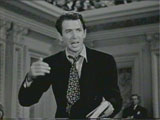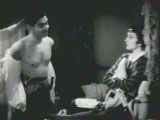|
|
|
It's hard to find a filmmaker who has had such a string of successes like Frank Capra—such a pile of Academy Award nominations, awards, and of course fan letters by the thousands. His classics really hit the market in a big way, especially between 1934 and 1946. Among those big hits were It Happened One Night, which garnered all five of the top Academy Awards, Mr. Deeds Goes To Town, Lost Horizon, You Can’t Take It With You, Mr. Smith Goes To Washington, Meet John Doe, It's A Wonderful Life. And of course, when he left the familiar area of activity and went into other genres he also had amazing successes. During World War II he put on a military uniform and, for the Army,
 |
Jimmy Stewart addresses Congress in Mr. Smith Goes To Washington.
28.8K |
56K
|
produced the Why We Fight documentary series which is really a classic among documentaries made in this country. Later in the fifties, he went on to television to produce the memorable series for children about science. And then finally, when movie-making was finished for him, he went into the back rooms of his library and wrote his autobiography; it went on to become the most noted of all of the stories about a career in Hollywood—a book called The Name Above The Title [Frank Capra, Frank Capra, The Name Above the Title: An Autobiography, (NY: Da Capo Press, 1997)].
So Capra is a stunning example of success—a success story for any number of Americans. It is an extraordinary story [about] somebody who came to this country at the age of six with a family of Sicilian immigrants. His brother, sisters, father, worked in the brickyards and olive oil plants, the candy stores and so on. But little Frankie got a break. He loved school, he was good at school, and the family let him pursue that little academic career. He excelled and went on to Cal Tech and majored in chemistry and the sciences. Then he somehow got into the movie business in San Francisco. He began to write routines for the old silents, the Our Gang comedy series. He became a director with Harry Cohn's second-rate movie studio called Columbia Pictures. And, thanks to Frank Capra, Columbia soon became a major player in the studio game. When sound came along, Capra emerged as the number-one producer/director of his era.
Did his pictures make an impact on American life? We can think of some amusing little examples. When Clark Gable was in It Happened One Night, and took off his shirt, and revealed that he had no undershirt, the undergarment industry in this country suffered a big dip in its profits. Men sensed that this was the way to dress. In Mr. Deeds Goes To Town, Gary Cooper—at the end of his trial—talked about doodling. That way he rescued an old word from the English vocabulary, that represented aimless scribbling. It became a household word. In Lost Horizon, he gave us the term "Shangri-la," which has become so familiar in our vocabulary.
 |
Clark Gable takes off his shirt in It Happened One Night.
28.8K |
56K
|
But can we speak about a more serious impact on American life and culture? Perhaps we can look to the The Negro Soldier—that movie in the Why We Fight series which some people say helped a great deal to break the Army's prejudice and to pave the way for the integration of the military in 1948.
But is there a bigger legacy for Capra, something larger, something that represents his contribution to our thinking in this country about individualism and democracy, an optimism? We remember Frank Capra for his fundamental optimism reflected in his movies. He expressed a faith in democracy, a confidence that good people could reform their society and their government, and make things work. He expressed a faith in the common man, the common woman—expressed in the movies often with the term "the little guy." These little guys and gals often came from small-town America, and they went up against the metropolis, usually represented by New York City. He seemed to suggest that these little people could succeed, to a degree, that they could make a difference; that they were not helpless as pessimists tend to conclude.
He also reminded us in his pictures of national symbols. He had Jimmy Stewart going off to the Lincoln Memorial to build up his spirit and he had Gary Cooper going to Grant's Tomb in New York City. Critics often made fun of these representations, calling them "Capra corn." But his defenders said that Capra understood that sensitive nerve in the American public. He reminded us of our ideals, and his background explained, in a way, his fundamental optimism: that he was a poor immigrant who succeeded tremendously in climbing the ladder of success and felt, with good reason, to love his adopted country.
Previous |
Next
Robert Brent Toplin
Part 1: A Stunning Example of Success
Part 2: This Notion That the Little Guy Has Dignity
Part 3: The Women Were Usually Strong
Part 4: Some Critical Questions
|